
Wetenschap
Raketlancering om supernovarest in beeld te brengen
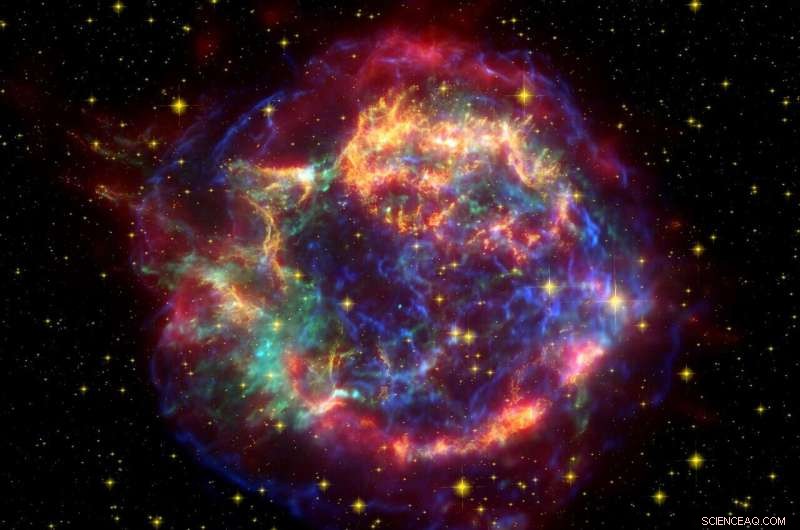
Cassiopeia A. Credit:NASA/CXC/SAO
Een astrofysica-team van de Northwestern University mikt op de sterren - nou ja, een dode ster, dat wil zeggen.
Op 21 augustus zal het door NASA gefinancierde team zijn "Micro-X" -raket lanceren vanaf White Sands Missile Range in het zuiden van New Mexico. De raket zal 15 minuten in de ruimte doorbrengen - net genoeg tijd om een snelle opname te maken van de supernovarest Cassiopeia A, een ster in het sterrenbeeld Cassiopeia die op ongeveer 11.000 lichtjaar van de aarde explodeerde. Daarna zal de raket met een parachute terug naar de aarde vliegen en landen in de woestijn - ongeveer 75 mijl van het lanceerplatform - waar het Northwestern-team zijn lading zal terugwinnen.
Afkorting van "hoge resolutie microcalorimeter röntgenbeeldvormingsraket", de Micro-X-raket zal een op supergeleiders gebaseerde röntgenbeeldvormingsspectrometer dragen die in staat is om de energie van elke binnenkomende röntgenstraling van astronomische bronnen met ongekende nauwkeurigheid te meten.
"Het overblijfsel van de supernova is zo heet dat het meeste licht dat het uitstraalt zich niet in het zichtbare bereik bevindt", zegt Enectali Figueroa-Feliciano van Northwestern, die het project leidt. "We moeten röntgenbeelden gebruiken, wat niet mogelijk is vanaf de aarde omdat onze atmosfeer röntgenstralen absorbeert. Daarom moeten we de ruimte in. Het is alsof je in de lucht springt, een foto maakt net zoals je hoofd gluurde boven de atmosfeer en landde toen weer naar beneden."
Figueroa-Feliciano is hoogleraar natuurkunde en astronomie aan het Weinberg College of Arts and Sciences en lid van Northwestern's Centre for Interdisciplinary Exploration and Research in Astrophysics (CIERA). Hij adviseerde een team van zeven afgestudeerde studenten, postdoctorale fellows en post-baccalaureaatsonderzoekers, die de afgelopen tien jaar de raket hebben gebouwd en getest.
Hoewel Micro-X zal lanceren vanuit New Mexico, bouwde het team de raket en zijn lading in het laboratorium van Figueroa-Feliciano op de Evanston-campus. Het lastigste is om de supergeleidende detectoren bij extreem lage temperaturen te houden - slechts een fractie van een graad boven het absolute nulpunt - zelfs als ze opwarmen terwijl ze door de atmosfeer breken. Het team loste dat probleem op met een thermoskan gevuld met vloeibaar helium, die tijdens de vlucht wordt ontkoppeld van de hitte en trillingen op de rakethuid.
"Constructing the Micro-X rocket is a challenging endeavor," Figueroa-Feliciano said. "Once it launches, it needs to be a completely hands-off process. It has to turn on, record data, store data and send data back to us autonomously. It gives the students an opportunity to learn how to build and test real technology."
Now in New Mexico, the team is assembling the rocket and readying it for flight. People can follow the team's journey on Instagram.
The team previously tested the six-story-tall rocket at NASA's Wallops Flight Facility in Virginia and launched it for the first time in summer 2018. During the rocket's first flight, the researchers demonstrated its detectors, along with their superconducting electronics readout, worked in space.
By studying the supernova remnant, which is 10 light-years across, Figueroa-Feliciano hopes to learn more about life on Earth—and inside our bodies.
"We're all made of star stuff," he said. "The elements in our bodies are made in the cores of stars. When stars explode, they shoot ejecta into space. Cassiopeia A is so big that the sun and the 14 closest stars to the sun would all fit inside the supernova remnant. The ejecta from these events spreads through the galaxy and ultimately ends up making planets like Earth."
Collaborating institutions include NASA's Goddard Space Flight Center, Lawrence Livermore National Laboratory, National Institute of Standards and Technology and University of Wisconsin at Madison. + Verder verkennen
Northwestern rocket to launch July 22 to explore 'star stuff'
 Platinacomplex remt metastase door conformationele modulatie van heparansulfaat
Platinacomplex remt metastase door conformationele modulatie van heparansulfaat Gecontroleerde fabricage van multimetalen bouwstenen voor hybride nanomaterialen
Gecontroleerde fabricage van multimetalen bouwstenen voor hybride nanomaterialen MRI-techniek detecteert de eigenschappen van verpakt vlees
MRI-techniek detecteert de eigenschappen van verpakt vlees Wetenschappers ontwikkelen nieuwe elektrochemische/fluorescerende dual-mode biosensor
Wetenschappers ontwikkelen nieuwe elektrochemische/fluorescerende dual-mode biosensor Spiropyran-gefunctionaliseerde fotochrome nylon banden voor langdurige detectie van ultraviolet licht
Spiropyran-gefunctionaliseerde fotochrome nylon banden voor langdurige detectie van ultraviolet licht
Hoofdlijnen
- Technologie die complexe moleculaire interacties simuleert, kan leiden tot betere behandelingen voor kanker en COVID-19
- Het sluiten van wegen gaat de effecten van habitatverlies voor grizzlyberen tegen
- Wat gebeurt er met een diercel wanneer deze zich in een hypotone oplossing bevindt?
- Ja,
- Wat doet de DNA-nucleotide volgorde code voor?
- Lake Michigan watervogels botulisme sterfgevallen in verband met warm water, algen
- Polen geeft giftige algen de schuld van vissterfte in Oder
- Microben die gaatjes veroorzaken, kunnen superorganismen vormen die kunnen kruipen en zich op de tanden kunnen verspreiden
- Meer wolfachtig worden is de sleutel tot de toekomst voor coyotes
- Herstelde Mission Control komt 50 jaar na Apollo tot leven
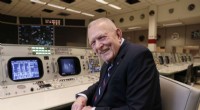
- Snelle radio-uitbarstingen, wendingen en geschreeuw helpen wetenschappers de bron van kosmische ontploffing te bepalen
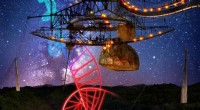
- Afbeelding:Antarctische mist
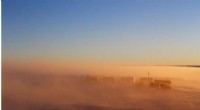
- Afbeelding:Model binaire asteroïden
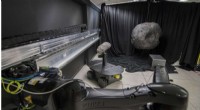
- Eerste bewijs dat water op het maanoppervlak kan worden gecreëerd door de magnetosfeer van de aarde
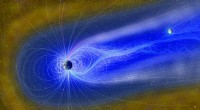
 Qualcomm introduceert 5G-chips van de derde generatie om snelheden en prestaties van mobiele apparaten te verbeteren
Qualcomm introduceert 5G-chips van de derde generatie om snelheden en prestaties van mobiele apparaten te verbeteren Een geschiedenis van computers voor kinderen
Een geschiedenis van computers voor kinderen  Piëzo-elektrische materialen vergroten hun potentieel met een methode voor flexibel plakken
Piëzo-elektrische materialen vergroten hun potentieel met een methode voor flexibel plakken Nieuwe buigbare smartphonetechnologie kan monitoring gebruiken om levens van patiënten te redden
Nieuwe buigbare smartphonetechnologie kan monitoring gebruiken om levens van patiënten te redden Knipperen zorgt voor moeilijk te verkrijgen 2D boornitride
Knipperen zorgt voor moeilijk te verkrijgen 2D boornitride Drie manieren om wetenschappelijk schrijven te verbeteren om meer citaten te krijgen
Drie manieren om wetenschappelijk schrijven te verbeteren om meer citaten te krijgen Radiotelescoop krijgt upgrade in Brookhaven lab
Radiotelescoop krijgt upgrade in Brookhaven lab Controle over de kristalstructuur van galliumoxide
Controle over de kristalstructuur van galliumoxide
- Elektronica
- Biologie
- Zonsverduistering
- Wiskunde
- French | Italian | Spanish | Portuguese | Swedish | German | Dutch | Danish | Norway |

-
Wetenschap © https://nl.scienceaq.com

